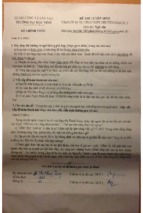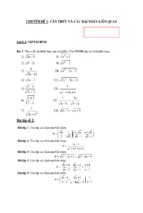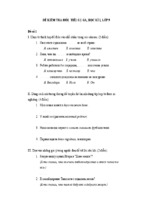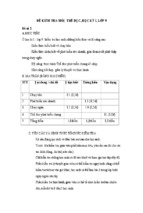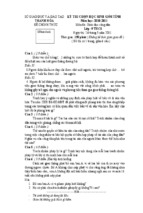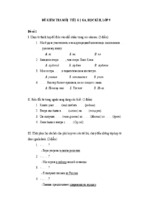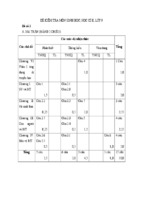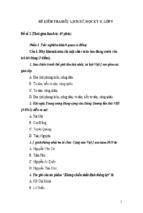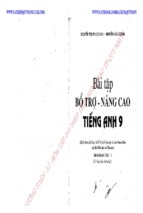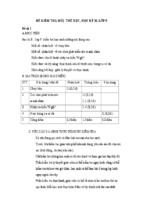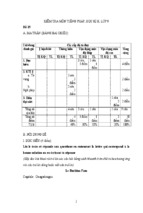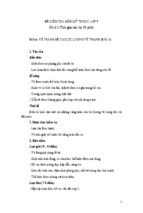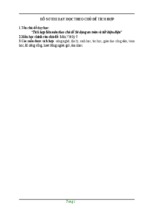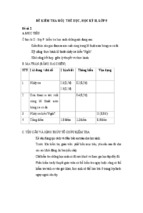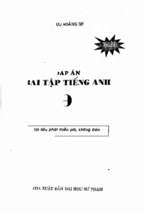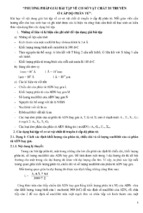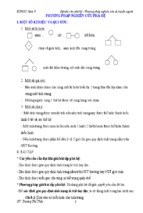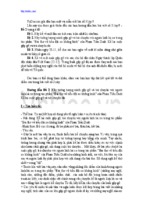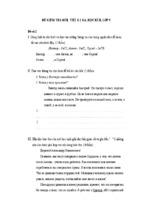Giáo trình dạy thêm tiếng Anh lớp 9
100 ENGLISH tests
Grade: 9
FIRST TERM
Teacher: Nguyễn Văn Dũng
Student: ……………………
1
BÍ QUYẾT NHỚ ĐỘNG TỪ BẤT QUY TẮC
IRREGULAR VERBS
Cách phát âm
Đuôi –ed có 3 cách đọc khác nhau: /t/, /d/ và /id/
Looked look/t/
Đuôi –ed được ph|t }m l{ /t/ sau những }m vô thanh (Cổ họng
Clapped clap/t/
không rung khi ph|t }m), những }m được ph|t ra bằng c|ch
Missed miss/t/
đẩy hơi qua miệng (không có }m từ cổ họng). Những }m vô
Watched watch/t/
thanh gồm: k, p, s, ch, sh, f.
Finished finish/t/
Smelled smell/d/
Saved save/d/
Đuôi –ed được ph|t }m l{ /d/ sau những }m hữu thanh (cổ
Cleaned clean/d/
họng rung khi ph|t }m), n{o, thử sờ cổ họng khi ph|t }m n{o!
Robbed rob/d/
Một số ví dụ về }m hữu thanh l{: l, v, n, b v{ c|c nguyên }m.
Played play/d/
Decided decide/id/
Đuôi –ed được ph|t ph}m l{ /id/ sau }m “t v{ d”. /id/ sẽ tạo
Needed need/id/
nên 1 }m tiết mới cho từ. (không thể n{o ph|t }m /tt/ hoặc
Wanted want/id/
/dd/ được m{!
Invited invite/id/
Xem them ai đ}y: https://x3english.com/dong-tu-bat-quy-tac
2
SỰ KHÁC BIỆT TRONG ANH – ANH, ANH – MỸ
A/ PHÁT ÂM : Anh – Anh (British English, viết tắt là Br.E) và Anh – Mỹ (American English,
viết tắt là Am.E hoặc A.E) l{ hai giọng (accent) của hai vùng kh|c nhau.
Anh – Anh
(British English – Br.E)
Phụ âm R ở cuối từ
Car
Floor
Board
Bare
Phụ âm /t/ ở giữa
2 nguyên âm
Item:
Bottle
Computer
Letter
Nguyên âm /æ/
Fast ·
Staff
Cat
Lamp læmp]
Nguyên âm o
(box, top, hot, god)
Document
Occupied ·
Copy
Monitor
Âm /r/ bị lược bỏ ho{n to{n
[(Br.E) kaː]
[(Br.E) flɔː]
[(Br.E) bɔːd]
[(Br.E) beə ]
Vẫn ph|t }m l{ “t” rõ r{ng v{
chính xác
[(Br.E) aɪ.təm ] ·
[(Br.E) bɔtl ]
[(Br.E) kəm’pju:tə]
[(Br.E) ‘letə]
Anh – Mỹ
(American English – Am.E)
Ph|t }m rất nặng v{ rõ, lưỡi
cong ngược v{o trong
[Am.E) kaːr]
[Am.E) flɔːr]
[Am.E) bɔːrd]
[Am.E) ber]
Ph|t }m nhẹ hơn, có xu
hướng thay thế “t” bằng “d”
[Am.E) aɪ.dəm ]
[Am.E) ba:dl]
·[Am.E) kəm’pju:dər]
[Am.E) ‘ledər]
- Đọc hẳn th{nh }m /a/
[(Br.E) f ːst ]
[(Br.E) st ːf ]
[(Br.E) k ːt]
[(Br.E) l ːmp ]
- Đọc th{nh }m nửa a nửa e.
[Am.E) fæst]
· [Am.E) stæf]
[Am.E) kæt]
[Am.E) læmp]
-Được ph|t }m tròn miệng l{ /ɒ/
[(Br.E) dɒkjʊmənt ]
[(Br.E) ɒkjʊpaɪd ]
[(Br.E) kɒpi ]
[(Br.E) mɒnɪtə ]
- Bị đọc trệch hẳn th{nh /a:/
[Am.E) d ːkjʊmənt]
[Am.E) ːkjʊpaɪd]
[Am.E) k ːpi]
[Am.E) m ːnɪtə ]
Either [ˈaɪðər]
·
Either [ˈiːðər]
Neither [ˈnaɪðər]
Neither [niːðɚ]
Via [vaɪə]
Via [viː.ə]
Privacy /’praɪvəcɪ/
Privacy [’prɪ:vəcɪ]
Các chú ý khác
Direction /daɪ'rekʃn/
Direction [dɪ:'rekʃn]
Clerk [kl ːk ]
Clerk [klɝːk]
Garage [g rid ]
Garage [gəˈr ː ]
Schedule [ˈʃɛdjuːl]
Schedule [skedju:l]
B/ Trọng âm: Những từ mượn của Ph|p như "garage" thì người Mỹ nhấn }m cuối trong khi người
Anh nhấn }m trước đó. C|c từ sau nằm trong số n{y: adult, ballet, baton, beret, bidet, blasé, brevet,
brochure, buffet, café, canard, chagrin, chalet, chauffeur, chiffon, cliché, coupé, croissant, debris,
debut, décor, detail, détente, flambé, frappé, garage, gateau, gourmet, lamé, montage, parquet,
pastel, pastille, pâté, précis, sachet etc.
C. Chọn học cách phát âm nào:
Học c|i n{o dễ với mình l{ được. Theo cảm quan c| nh}n của mình, Anh-Mỹ dễ hơn, dễ bắt chước
hơn thì đúng hơn v{ được nhiều người nói hơn. C|c bạn có thể v{o link
sau http://www.youtube.com/watch?v=UnhzA9GrF1o
D/ CÁCH DÙNG TỪ TRONG VĂN NÓI
3
1. Cách dùng 'just', 'already' hay 'yet':
Người Mỹ dùng từ 'just', 'already' hay 'yet' trong thì qu| khứ đơn giản- the simple past tense,
trong khi tại người Anh thường dùng những từ đó ở thì hiện tại ho{n th{nh - the present perfect.
Ví dụ:
Người Mỹ nói: "I already had lunch." hay "She didn't arrive yet."
Người Anh nói: "I've already had lunch." hay...: "She hasn't arrived yet."
2. Cách nói giờ
Nếu muốn nói 2:45 - 2h45 tại Anh, chúng ta có thể nói:
"Quarter to three", hay 3:15 - 3h15 có thể nói "Quarter past three".
Trong khi đó, tại Mỹ, nói giờ như sau:
"Quarter of three" để chỉ 2:45, hay "Quarter after three" để chỉ 3:15.
3. Người Anh và người Mỹ cũng khác nhau trong cách nói:
_ GOOD: người Mỹ dùng good thay cho well, VD: I feel good (M) = I feel weel (A)
_ Người Anh dùng 'have got' hay 'has got' khi nói về sở hữu, trong khi người Mỹ thì thường hay
dùng 'have' hay 'has'.
Ví dụ, tiếng Anh Mỹ, chúng ta có thể nói: "I have a new car."
Còn trong tiếng Anh Anh thì thường l{: "I've got a new car."
(Về mặt nghĩa, hai c}u trên không kh|c nhau)
_ Dạng Past Participle của GET, người Mỹ dùng l{ GOT, còn người Anh dùng l{ GOTTEN.
_ Với động từ AIM, người Mỹ dùng cấu trúc “to aim to + V”, còn người anh dùng cấu trúc “to aim at
+ V ing”. Ví dụ: We aim to do something nice = We aim at doing something nice.
E/ MỘT SỐ TỪ THÔNG DỤNG
1. Luật sư:
Attorney (M) –
Barrister, Solicitor (A)
2. Hiệu s|ch:
Bookstore(M)
–
Bookshop (A)
3. Ô tô:
Automobile (M)
–
Motor car (A)
4. Bản mẫu có chỗ trống để điền v{o: Blank (M) –
Form (A)
5. Danh thiếp:
Calling card (M)
–
Visiting card (A)
6. Kẹo:
Candy (M)
–
Sweets (A)
7. Cửa h{ng kẹo:
Candy store (M)
–
Sweet shop (A)
8. Toa xe lửa:
car (M)
–
coach, carriage (A)
9. Ngô:
Corn (M)
–
Maize, Indian corn (A)
10. Lúa mì:
grain, wheat (M)
–
corn (A)
11. Thị sảnh:
City Hall (M) –
Town Hall (A)
12. Bánh quy:
Cracker (M)
–
Biscuit (A)
13. Đạo diễn điện ảnh:
Director (M) –
Producer (A).
14. Trung t}m doanh nghiệp th{nh phố: downtown (M) – city (A)
15. Hiệu thuốc:
Drugstore (M)
–
Chemist’s. Chemist’s shop (A)
16. Thang máy:
Elevator (M) –
Lift (A)
17. Xăng:
Gas hay gasonline (M) –
Petrol (A)
18. Dầu hỏa:
Kerosene (M)
–
Paraffin (A)
19. Mùa thu:
Fall (M)
–
Autumn (A)
20. Tên (người):
First name hay given name (M) – Christian name (A)
21. Vỉa hè:
Sidewalk (M) –
Pavement (A)
22. Đường sắt:
Railroad (M) –
Railway (A)
23. Cửa h{ng tự phục vụ: Supermarket (M)
–
Self-service shop (A).
24. Sinh viên năm thứ nhất: Freshman (M)
–
First year student (A)
25. Sinh viên năm thứ hai: Sophomore (M)
–
Second year student (A)
26. Sinh viên năm thứ ba: Junior (M)
–
Third year student (A)
27. Sinh viên năm cuối: Senior (M)
–
Last year student (A)
4
V1
1.
2.
3.
4.
5.
6.
7.
8.
9.
10.
11.
12.
13.
14.
15.
16.
17.
18.
19.
20.
21.
22.
23.
24.
25.
26.
27.
28.
29.
30.
31.
32.
33.
34.
35.
36.
37.
38.
39.
40.
41.
42.
43.
44.
Be
(am, is, are)
Become
Begin
Bite
Blow
Break
Bring
Build
Burn
Buy
Cast
Catch
Choose
Come
Cut
Do
Draw
Drink
Drive
Eat
Fall
Feed
Feel
Fight
Find
Fly
Forget
Get
Give
Go
Grow
Hang
Have
Hear
Hide
Hold
Hurt
Keep
Know
Lead
Learn
Leave
Lend
Let
LIST OF IRREGULAR VERBS
V2
V3
was/ were
been
Ngh a
Thì, l{, ở
became
began
bit
blew
broke
brought
built
Burnt
bought
Cast
caught
chose
came
cut
did
drew
drank
drove
ate
fell
fed
felt
fought
found
flew
forgot
got
gave
went
grew
hung
had
heard
hid
held
hurt
kept
knew
led
learnt
left
lent
let
trở nên
Bắt đầu
Cắn
Thổi
hỏng
Mang
x}y dựng
Cháy
mua
Đuc
bắt
Chọn
đến
cắt tỉa
làm
Rút ra
say
Lái xe
Ăn
rơi
nuôi
cảm thấy
chiến đấu
tìm
Bay
quên
có
được
đi
mới lớn
treo
có
nghe
Ẩn
tổ chức
đau
Giữ
Nổi tiếng
Dẫn
đ~
Rời khỏi
Cho vay
Để cho
become
begun
bitten
blown
broken
brought
built
Burnt
bought
cast
caught
chosen
come
cut
done
drawn
drunk
driven
eaten
fallen
fed
felt
fought
found
Flown
forgotten
got
given
gone
grown
hung
had
heard
hidden
held
hurt
kept
known
led
learnt
left
lent
Let
5
45.
46.
47.
48.
49.
50.
51.
52.
53.
54.
55.
56.
57.
58.
59.
60.
61.
62.
63.
64.
65.
66.
67.
68.
69.
70.
71.
72.
73.
74.
75.
76.
77.
78.
79.
80.
81.
82.
83.
Lose
Make
Meet
Pay
Put
Read
Ride
Ring
Rise
Run
Say
See
Sell
Send
Shine
Show
Sing
Sit
Sleep
Smell
Speak
Spend
Spoil
Stand
Steal
Sweep
Swim
Take
Teach
Tell
Think
Throw
Understand
Wake
wear
Weave
Win
Write
lost
made
met
paid
put
read
rode
rang
rose
ran
said
saw
sold
sent
shone
showed
sang
sat
slept
smelt
spoke
spent
Spoil/ed
stood
stole
swept
swam
took
taught
told
thought
threw
understood
woke
wore
Wove
Won
wrote
lost
made
met
paid
put
read
ridden
rung
risen
run
said
seen
sold
sent
shone
shown
sung
sat
slept
smelt
spoken
spent
Spiol/ed
stood
stolen
swept
swum
taken
taught
told
thought
thrown
understood
woken
worn
Woven
Won
written
Thua
Chế tạo
Gặp
Trả
Đặt
Đọc
Đa xe
Nhẫn
Tăng lên
Chạy
Nói
Xem
Bán
Gửi
Tỏa s|ng
Chỉ
Hát
Ngồi
Ngủ
Mùi
Nói
Tiêu
Bị giật
Đứng
Lấy trộm
Quét
Bơi
Lấy
Dạy
Nói
Nghĩ
Ném
hiểu
T nh giac
mặc
Det, đan
thắng
Viết
6
8.
Add
Advise
Arrive
Ask
Attend
Attract
Avoid
Behave
LIST OF REGULAR VERBS
Added
Added
Advised
Advised
Arrived
Arrived
Asked
Asked
Attended
Attended
Attracted
Attracted
Avoided
Avoided
Behaved
Behaved
Thêm
Khuyên
Đến
Yêu cầu
Tham dự
Thu hút
Tránh
Cư xử
9.
Believe
Believed
Believed
Tin
10.
Borrow
Borrowed
Borrowed
Mượn
11.
Carve
Carved
Carved
Cham, khac
12.
Change
Changed
Changed
Thay đổi
13.
Clean
Cleaned
Cleaned
L{m vệ sinh
14.
Collect
Collected
Collected
Thu
15.
Cross
Crossed
Crossed
Vượt qua
16.
Decide
Decided
Decided
Quyết định
17.
Decorate
Decorated
Decorated
Trang trí
18.
Depend
Depended
Depended
Phụ thuộc
19.
Develop
Developed
Developed
Ph|t triển
20.
Divide
Divided
Divided
Chia
21.
Discover
Discovered
Discovered
Ph|t hiện
22.
Dislike
Disliked
Disliked
Không thích
23.
Embroider
Embroidered
Embroidered
Thêu
24.
Enjoy
Enjoyed
Enjoyed
Thích
25.
Explore
Explored
Explored
Khám phá
26.
Fill
Filled
Filled
Đầy
27.
Finish
Finished
Finished
Kết thúc
28.
Fit
Fitted
Fitted
Trang bị
29.
Gather
Gathered
Gathered
Thu thập
30.
Hate
Hated
Hated
Ghét
31.
Help
Helped
Helped
Giúp
32.
Hope
Hoped
Hoped
Hi vọng
33.
Introduce
Introduced
Introduced
Giới thiệu
34.
Invent
Invented
Invented
Phát minh
35.
Join
Joined
Joined
Gia nhập
36.
Knit
Knit
Knit
Đan ch
37.
Learn
Learned
Learned
Học
38.
Like
Liked
Liked
Đ~ thích
39.
Listen
Listened
Listened
Nghe
40.
Live
Lived
Lived
Sống
41.
Look
Looked
Looked
Nhìn
42.
Love
Loved
Loved
Yêu
43.
Manage
Managed
Managed
Quản lý
1.
2.
3.
4.
5.
6.
7.
7
44.
Mind
Minded
Minded
Tâm lý
45.
Miss
Missed
Missed
Bỏ lỡ
46.
Mould
Mould
Mould
Đuc
47.
Move
Moved
Moved
Di chuyển
48.
Need
Needed
Needed
Cần
49.
Open
Opened
Opened
Mở
50.
Organize
Organized
Organized
Tổ chức
51.
Paint
Painted
Painted
Sơn
52.
Pass
Passed
Passed
Thông qua
53.
Perform
Performed
Performed
Thực hiện
54.
Plant
Planted
Planted
Trồng
55.
Practice
Practiced
Practiced
Thực h{nh
56.
Prefer
Prefered
Preferred
Ưu tiên
57.
Prevent
Prevented
Prevented
Phòng ngừa
58.
Promise
Promised
Promised
Hứa
59.
Protect
Protected
Protected
Bảo vệ
60.
Receive
Received
Received
Nhận
61.
Rely
Relied
Relied
Dựa
62.
Remember
Remembered
Remembered
Nhớ lại
63.
Rent
Rented
Rented
Thuê
64.
Report
Reported
Reported
Báo cáo
65.
Request
Requested
Requested
Yêu cầu
66.
Return
Returned
Returned
Trả lại
67.
Seem
Seemed
Seemed
Có vẻ
68.
Smile
Smiled
Smiled
Mỉm cười
69.
Start
Started
Started
Bắt đầu
70.
Stay
Stayed
Stayed
Ở lại
71.
Stop
Stopped
Stopped
Dừng lại
72.
Study
Studied
Studied
Học
73.
Suggest
Suggested
Suggested
Đề xuất
74.
Talk
Talked
Talked
Nói chuyện
75.
Travel
Traveled
Traveled
Đi du lịch
76.
Try
Tried
Tried
Thử
77.
Use
Used
Used
Sử dụng
78.
Visit
Visited
Visited
Truy cập
79.
Wait
Waited
Waited
Đợi
80.
Want
Wanted
Wanted
Truy nã
81.
Wash
Washed
Washed
Rửa sạch
82.
Watch
Watched
Watched
Xem
83.
Weigh
Weighed
Weighed
C}n nặng
84.
Work
Worked
Worked
L{m việc
8
UNIT 1: LOCAL ENVIRONMENT
A PHONETICS
I- Underline the content words that are stressed in the following sentences. Practise
reading the sentences aloud.
1. This tour takes you to the outskirts of Hue.
2. During their stay in Hanoi, most tourists insist on a trip to Van Phuc Silk Village.
3. Banh chung of Tranh Khuc Village is famous for its distinctive flavour.
4. Cao Thon craft village in Hung Yen is among the largest incense-making villages in Viet Nam.
5. Nhat Tan peach flowers have become a brand of Ha Noi.
6. Pomelos from Phu Dien Village in Ha Noi is the most famous for its special taste.
7. For Hmong women, traditional clothing consists of an outer garment with a colorful and
decorative collar.
8. Not only domestically famous, products of the village have been in many countries around the
world.
II- Find the word which has a different sound in the part underlined.
1. A. paintings
B. weaving
C. casting
D. moulding
2. A. pottery
B. lacquerware
C. vase
D. silk
3. A. when
B. though
C. if
D. during
4. A. clumsy
B. cute
C. just
D. but
5. A. tourist
B. artistian
C. customer
D. souvenir
6. A. pass down
B. live on
C. turn down
D. make in
7. A. arrival
B. traditional
C. conical
D. historical
8. A. thirty
B. them
C. both
D. theme
9. A. schedule
B. when
C. red
D. comedy
B. VOCABULARY & GRAMMAR
I- Write the name of each traditional handicraft in the box under the picture.
Paintings
pottery
drums
silk
lanterns
lacquerware
marble
sculptures
conical
hats
9
carve
cast
weave
embroider
knit
mould
II -Find which word does not belong to each group.
1. A. paintings
B. weaving
C. casting
2. A. pottery
B. lacquerware
C. vase
3. A. when
B. though
C. if
4. A. stone
B. wood
C. eggshells
5. A. tourist
B. artistian
C. customer
6. A. pass down
B. live on
C. turn down
7. A. arrival
B. traditional
C. conical
8. A. bronz
B. gold
C. silk
9. A. basket
B. swearter
C. toy
10 A. cinema
B. park
C. museum
D. moulding
D. silk
D. during
D. handkerchief
D. souvenir
D. make in
D. historical
D. iron
D. hat
D. univesty
III. Match a word in column A with the appropriate word in B to form the correct phrase:
A
B
1. carve:
a. bronze, gold, iron
1. _____________________rector
2. cast:
b. sweaters, toys, hats
2. _____________________
3. weave:
c. clay, cheese, chocolate
3. _____________________
4. embroider:
d. stone, wood, eggshells
4. _____________________
5. knit:
e. baskets, carpets, silk, cloth
5. _____________________
6. mould:
f. handkerchiefs, tablecloths, pictures 6. _____________________
IV-Fill in each blank with the correct form of the verbs from the box.
paintings
lacquerware
pottery
marble
drums
silk
sculptures
1. The birthplace of the famous bai tho
lanterns
conical
hats
________________________ is Tay Ho village in Hue.
10
2. If you go to Hoi An on the 15th of each lunar month, you can enjoy the lights of many
beautiful ________________________.
3. Van Phuc village in Ha Noi produces different types of ________________________ products such as
cloth, scarves, ties, and dresses.
4. On the Tet holiday, many Hanoians go to Dong Ho village to buy folk ____________________ .
5. ________________________ products of Bau Truc, such as pots and vases, have the natural colours
typical of Champa culture in Ninh Thuan.
6. Going to Non Nuoc marble village in Da Nang, we’re impressed by a wide variety
of ________________________ from Buddha statues to bracelets.
V-Fill in each blank with the correct form of the verbs from the box.
cover
make
cast
carve
knit
draw
embroider
mould
1. Every region has a different quality of clay, varnish color. ________________________________ and
burning
technique in pottery making.
2. Recently. Southeast Asia's largest bronze statue of the Buddha erected in Bai Dinh
pagoda was _________________________ by artisans from Van Diem bronze village.
3. ______________________ cocoon silk was one of the women’s chores 3,000 years ago.
4. At the beginning of the 20lh century, Vietnamese artists used lacquering techniques to
draw and _________________________pictures for decorations.
5. In the early 20th century, most houses, beds, and household were ___________ from
bamboo and rattan.
6. With only needles and colorful rolls of thread, craftswomen _____________________ ________________
silk
pictures, usually of natural wonders such as birds, plants, or landscapes.
7. Conical hats are __________________by using young palm leaves along a circular bamboo frame.
8. In Dong Ho Village (Bac Ninh) or Sinh Village (Hue), the painter who ___________________________________
the folk picture is a craft village farmer.
VI Put the words or phrases in the box in the correct column. We can put some wore in more
than one column.
opera house
museum
café
beauty spot
building
temple
craft village
building
cinema
shopping district
market
club
library
craft village
park
zoo
viewer
department store
restaurant
cinema
Entertaining
______________________
______________________
______________________
______________________
______________________
______________________
______________________
Educational
______________________
______________________
______________________
______________________
______________________
______________________
______________________
Cultural
______________________
______________________
______________________
______________________
______________________
______________________
______________________
Historical
______________________
______________________
______________________
______________________
______________________
______________________
______________________
11
PHRASAL VERBS
1.
2.
3.
4.
5.
6.
7.
8.
9.
10.
11.
12.
13.
14.
15.
16.
bring out: publish/launch
close down: stop doing business
come back: return
deal with: take action to solve a problem
get up: get out of bed
face up to: accept, deal with
find out: get information
get on with: have a friendly relationship
with somebody
give up: stop doing something
keep up with: stay equal with
look through: read
look forward to: be thinking with pleasure
about something to come
live on: have enough money to live
pass down: transfer from one generation
to the next
run out of: have no more of
turn down: reject or refuse something
1.
2.
3.
4.
5.
6.
7.
8.
9.
10.
11.
12.
13.
14.
15.
16.
đưa ra (xuất bản / khởi động)
đóng cửa: ngừng kinh doanh
trở lại: trở về
đối phó với: h{nh động để giải quyết một
vấn đề
dậy (ra khỏi giường)
đối mặt với: chấp nhận, đối phó với
tìm hiểu (có được thông tin)
hòa hợp với: có một mối quan hệ th}n thiện
với ai đó
bỏ: ngừng l{m một c|i gì đó
theo kịp với (tương ứng với)
xem xét thông qua (đọc)
mong muốn (suy nghĩ h|o hức về việc gì
sắp đến)
sống nhờ v{o: có đủ tiền để sống
truyền lại: chuyển từ một thế hệ tiếp theo
hết (không có thêm)
từ chối
VII Rewrite each sentence so that it contains the phrasal verb 3B1 brackets. You may
have to change the form of the verb.
1. I don't remember exactly when my parents started this workshop. (set up)
________________________________________________________________________________________________.
2. We have to try harder so that our handicrafts can stay equal with theirs. (keep up with)
________________________________________________________________________________________________.
3. What time will you begin your journey to Da Lat? (set off)
________________________________________________________________________________________________.
4. We arranged to meet in front of the lantern shop at 8 o'clock, but she never arrived. (turn up)
________________________________________________________________________________________________.
5. The artisans in my village can earn enough money from basket weaving to live. (live on)
________________________________________________________________________________________________.
VIII. Complete each sentence using the correct form of a phrasai verb in 4. You don't need
to use ail the verbs.
1. We must ________________________the reality that our handicrafts are in competition with those of
other villages.
2. I invited her to join our trip to Trang An, but she ________________________my invitation.
3. The craft of basket weaving is usually ________________________from generation to generation.
4. Do you think we can ________________________selling silk scarves as souvenirs?
5. They had to ________________________the museum because it's no longer a place of interest.
6. What time________________________you ________________________from the trip fast night?
IX Complete the second sentence so that it has a similar meaning to the first sentence, using
the word given.
7.
Where did you get the information about Disneyland Resort? Find
Where………………………………………………………………. ?
8.
What time did you get out of bed this morning? Up
When………………………………………………………………. ?
12
ru read this leaflet to see what activities are organised at this attraction. Look
I’ll ……………………………………………………………….
10.
They're going to publish a guidebook to different beauty spots in Viet Nam. out
They’re ……………………………………………………………….
11.
I’m thinking with please=ure about the weekend! Forward
I’m ……………………………………………………………….
X. Choose the best:
1. The flower was _____________ out of a single piece of valuable wood.
A.carved
B.moulded
C.cast
D.given
2. In this town, they _____________ all the frames in steel.
A.make
B.have
C.mould
D.cast
3. She is skilled at _____________ cloth.
A.giving
B.weaving
C.doing
D.carving
4. If you like, I can _____________ flowers on the cushion covers for you.
A.grow
B.make
C.embroider
D.knit
5. Is it true that you _____________ this woollen hat yourself?
A.knitted
B.wove
C.did
D.carved
6. The doll has been _____________ out of clay.
A.embroidered
B.cast
C.woven
D.moulded
7. I love going to this place _____________ it’s the quietest place in the city.
A.so
B.though
C.so that
D.as
8. They keep changing the decoration of the shop _____________ they can attract more young
people.A.so that
B.because
C.although
D.when
9. _____________ she’s young, she’s the most famous artisan in the village.
A.When
B.Although
C.Whereas
D.In order to
10. Do you know who’s _____________ his pottery workshop?
A.bringing out
B.taking over C.passing down
D.turning down
11. I’ve _____________ the product catalogue and decided to buy this table.
A.found out
B.closed down
C.looked through
D.lived on
12. This sports centre is so small that it cannot _____________ the demands of local residents.
A.keep up with
B.face up to
C.deal about
D.set up
13 These products are called _____________ because they are decoratively covered with lacquer.
A. lacquerware
B. pottery
C. drum
D. silk
14. These _____________ are made of thin bamboo strips that are woven together.
A. paintings
B. silk
C. conical hats
D. baskets
15. To play this _____________ you should use your hands, not sticks.
A. pottery
B. drum
C. lacquerware
D. baskets
16. This vase is a beautiful piece of_____________ . It’s made from clay dug from our river banks.
A. lacquerware
B. pottery
C. conical hats
D. baskets
17. Lots of Vietnamese girls like wearing _____________ and ao dai.
a. latterns
B. paintings
C. conical hats
D. paintings
18. When I go somewhere on holiday, I usually buy _____________ as souvenirs because I love works
of art.
A. attractions
B. paintings
C. business
D. culture
19. I love going to this place _____________ it's the quietest place in the city,
A. so
B. though
C. so that
D. as
20. They keep changing the decoration of the shop _____________ they can attract more young
people.
A. so that
B. because
C . although
D. when
9.
13
21. _____________ she's young, she's the most famous artisan in the village.
A. When
B. Although
C . Whereas
D. In order to
22. _____________ people talk about traditional paintings, they think of Dong Ho village.
A. so that
B. because
C . although
D. when
23. My sister went to Tay Ho village in Hue _____________ she could buy some bai tho conical hats.
A. so that
B. because
C . although
D. when
24. _____________ this museum is small, it has many unique artefacts.
A. so that
B. because
C . although
D. when
25. This square is our favourite place to hang out _____________ we have space to skateboard.
A. so that
B. because
C . although
D. when
26. The villagers have to dry the buffalo skin under the sun _____________ they make the drumheads.
A. before
B. after
C . while
D. when
27. _____________ there are modern knitting machines. The artisans in my village like using
traditional looms.
A. So that
B. ecause
C . Although
D. When
28. Many children like to go to Bat Trang Ceramic village_____________ they can make their own
pottery there.
A. so that
B. as
C . although
D. when
29. We have to follow more than ten stages_____________ we can make a simple conical hat.
A. so that
B. because
C . although
D. when
30. Sinh paintings are special. They are burned after worship.
A. so that
B. Since
C . Although
D. When
B. SPEAKING:
Practice the dialogue
TOPIC 1: Local environment
1. Which place of interest should a visitor pay a visit in your area?
- I think in my area, visitors should visit Ninh Chu beach.
2. What activities can tourists enjoy?
- They can sunbathe on the beautiful beach, eat different kinds of seafood, swim in the clear
water and visit Cham Towel or Cham Cultural Museum.
3. How will they feel if they are in this place?
- They will have a special experience. They will also have a memorable and an unforgotable
time.
II. Now I’m going to ask you FOUR questions about your friends. Are you ready?
1. What is your favourite place of interest in your town/city?
2. Who do you want to go there with?
3. What can you do there?
4. Why do you like it?
III. Each of you will now receive a pair of cards. On one card there is a short notice and on the
other card there are clues for five questions. You should use the clues to make questions and ask
your friend. Your friend will answer the questions based on the notice he/she has. Here are your
cards. You will have 30 seconds to prepare. You can make notes on the paper.
14
C. READING:
I Read the passage, and decide whether the following statements are true (T), or false (F).
Bau Truc pottery items are made from clay from the Quao River
mixed with sand. Clay is collected from the river only once a year,
each lasting for half a month. Clay is taken more or less depending
on the ability of each person. In the clay collecting season, local
people try to take as much clay as they can to store, for use in the
entire year.
15
Currently, people in Bau True pottery village still make pottery items in the traditional way.
They do not use the wheel but the craftsmen have to turn around the products. The potters shape
their products by skillful hands and feet around a pole-round pillar, rather than on the wheel.
From this step, silky clay block initially gradually forms a smooth rounded hollow blocks, then the
formation of flower vases, or water pots.
Bau True’s craftsmen use wet cloths to make the product surface smooth. These items are
decorated with seashells, snails or hand-made paintings featuring the daily life of Bau True’s
people
1. Clay can be collected from the Quao River all year round.
2. Bau True pottery is famous because people only use fine clay to make their
T
□
□
F
□
□
products.
3. People still make the pottery in the traditional way.
□
□
4. Craftsmen shape the pottery items only with their hands and feet.
□
□
5. The pots nowadays are shaped on the potter’s wheel.
6. Craftsmen use simple ways to make the product surface smooth.
□
□
7. The craftsmen’s skills can make the blocks of clay become lively and useful.
□
□
8. The designs of Bau True pottery reflect the life of local people.
II. Read the passage, and do the tasks that follow.
□
□
Bat Trang Pottery Village
Bat Trang. a traditional porcelain and pottery village
with history of seven centuries, is an interesting attraction in
□
□
Ha Noi that tourists should not ignore.
Bat Trang. a traditional porcelain and pottery village
with history of seven centuries, is an interesting attraction in
Ha Noi that tourists should not ignore. Bat Trang, a
traditional porcelain and pottery village with history of
seven centuries, is an interesting attraction in Ha Noi that
tourists should not ignore.
during the 15th-17th centuries. Bat Trang“ s ceramics were favourite products not only in the
domestic market, but also foreign ones thanks to Japanese. Chinese and Western trading boats
that passed by.
In the 18ihand 19th centuries, due to restricting foreign trade policy of Trinh, Nguyen
dynasties, it was difficult for pottery products in Viet Nam to be exported to foreign countries, and
some famous pottery-making villages like Bat Trang. or Chu Dau (Hai Duong province) went
through a hard time. Since 1986. thanks to economic reforms and development, more attention
has been paid to the village and the world gets a chance to know more about Vietnamese
porcelain through many high quality exported Bat Trang's ceramic products.
Bat Trang ceramics are produced for daily household use (bows. cups, plates, pots, bottles...),
worshipping, or decoration purposes. Nowadays, the pottery artists bring into ceramics many
innovations in production techniques, and creativity in products' features, so many new products
have been made, and even daily household items may have the beauty like decoration ones.
Visiting Bat Trang, tourists can visit Bat Trang Porcelain and Pottery Market where they can
directly make pottery products by themselves. Many youngsters and foreign tourists are
interested in this pottery-making experience, and spend a whole day in the market making a
souvenir for their families or friends.
Task I: Match a word in column A with its definition in column B, writing the answer in each
blank.
16
Answer
A
B
1. rich (adj)
A. of or inside a particular country
2. domestic (adj)
B. limiting a certain activity
3. restricting (adj)
4. innovations (n)
C. new ideas or methods
D. containing a lot of something
True or false (F).
1. Many Japanese. Chinese and Western trading boats came to Pho Hien during the
15 th and 17lh centuries.
2. Artisans in Bat Trang village have always kept the traditions without any changes.
3. Bat Trang village has been the only centre of pottery in the north of Viet Nam for
centuries.
4. Political policies have had influence on the development of pottery and ceramic
crafts.
5. Tourists may have experience of making pottery pieces by themselves.
III-Read the passage, and do the tasks that follow.
Cham Brocade Weaving Village
1 ___________________________________________________________
The brocade weaving craft of Cham ethnic people in Mv Nghiep
not only carries the traditional beauty of brocade but also fills
with the typical Cham cultural value with original designs and
variable products such as: sarong, shawl, hat. overcoat…
□
□
□
□
□
□
□
□
□
□
2 Located at about 10km south of Phan Rang City. My Nghiep Village belongs to Ninh Phuoc and it
is the only traditional brocade weav ing of Cham people in Ninh Thuan. According to local people.
Polnuga King was a famous artisan who created this craft and taught villagers about the spinning
and weaving since the 1 1th century.
3 ______________________________________________________________
Long time ago. My Nghiep villagers planted cotton for materials, used spate and Chum Bau trees
and thin mud for dyeing materials, and used simple looms to make quality products and artistic
flower designs on fabric. Their products have been sold to Cham people as well as other
neighbouring inhabitants.
4 ______________________________________________________________
Through many ups and downs, the brocade w eaving of the Cham people has been well
developed. Visiting My Nghiep village, you will have chance to see the skillful hands of weavers
and artisans to make sophisticated brocade products such as skirts, coats, scarves, table cloths,
bed covers, belts... with different designs.
5 ______________________________________________________________
You will be attracted by the original and natural designs and colours. Each brocade is almost
unique because of the creation and sudden inspiration of My Nghiep villagers It is very easy to
notice the ideas and sentiments of Cham people in each brocade to create a typical Cham cultural
message to pass down from generation to generation.
6 ______________________________________________________________
The harmony combination of tradition and modem helps brocade get a strong foothold in local
and international markets. In recent years, there are more and more tourists coming to My Nghiep
17
village. Especially, foreigners are very keen on the sarong which is a formal dress of ancient King
and Queen w’ith sophisticated designs and made by soft fabric material.
Task 1. Match the headings with the paragraphs.
A. The distinctive features of My Nghiep brocade
B. The way to make traditional products
C. Present status of the craft
D. Introduction to the village
E. Efforts to keep the traditional craft
F. Location and its origin
Task 2: Match a word in column A with its definition in column B, writing the answer in each
blank.
Answer
A
1. looms
2. ups and down
3. sentiments
B
4. foothold
A. a strong position
B. gentle feelings
C. a long piece of thin cloth which is worn wrapped around the
waist
D. the idea that you want to make someone understand
5. message
6. sarong
E. equipment that is used for making cloth
F. a mixture of good and bad things
Task 3. Read the passage again, and answer the questions.
1. Who taught Cham people the brocade weaving craft?
______________________________________________________________________________________________________
2. What were the materials of making brocade?
______________________________________________________________________________________________________
3. What are the typical products of My Nghiep village?
______________________________________________________________________________________________________
4. What makes their products unique?
______________________________________________________________________________________________________
5. What is the message that Cham people want to pass down to future generations?
______________________________________________________________________________________________________
6 Which product are foreigners very interested in? Why?
______________________________________________________________________________________________________
D. WRITING
I. Rewrite the sentences:
1. I got the information about Disneyland Resort. (find out)
______________________________________________________________________________________________________
2. She got out of bed this morning. (get up)
______________________________________________________________________________________________________
3. I’ll read this leaflet to see what activities are organised at this attraction. (look through)
______________________________________________________________________________________________________
4. They're going to publish a guidebook to different beauty spots in Viet Nam. (bring about)
______________________________________________________________________________________________________
5. I’m thinking with please=ure about the weekend! (look forward to)
______________________________________________________________________________________________________
6. don’t remember exactly when my parents started this workshop. (set up) .
______________________________________________________________________________________________________
18
7. We have to try harder so that our handicrafts can stay equal with theirs. (keep up with) .
______________________________________________________________________________________________________
8. What time will you begin your journey to Da Lat? (set off) ?
______________________________________________________________________________________________________
9. We arranged to meet in front of the lantern shop at 8 o’clock, but she never arrived. (turn up) .
______________________________________________________________________________________________________
10 The artisans in my village can earn enough money from basket weaving to live. (live on) .
______________________________________________________________________________________________________
11. There are modern knitting machines. The artisans in my village like using traditional
looms. (although)
______________________________________________________________________________________________________
12. Many children like to go to Bat Trang Ceramic village. They can make their own pottery
there. (as)
______________________________________________________________________________________________________
13. We have to follow more than ten stages. We can make a simple conical hat. (so that)
______________________________________________________________________________________________________
14. Sinh paintings are special. They are burned after worship. (since)
______________________________________________________________________________________________________
15. We’ll have to phone you first. Then we’ll organise the trip. (before)
______________________________________________________________________________________________________
1 6. We were visiting an old building. They were going to a traditional market. (while)
______________________________________________________________________________________________________
II-Write an email to your pen friend about a trip to craft villages around Hoi An, using the
words or phrases below to make complete sentences. Add more words, if necessary.
Dear David,
1. You/ start/ trip/ taking/ short walk down/ harbor/ Hoi An/ where/ you/ board/ wooden
boat.
______________________________________________________________________________________________________
______________________________________________________________________________________________________
2. First/ you/ get/ pottery Thanh Ha village/ where/ local people/ continue/ make/ craft pots/
hand.
______________________________________________________________________________________________________
______________________________________________________________________________________________________
3. Then/ you/ continue/ visit/ carpentry village/ Kim Bong/ which/ have/ huge influence/
architecture/ Hoi An.
______________________________________________________________________________________________________
______________________________________________________________________________________________________
The traditional carpentry/ keep/ alive/ and/ still used/ restoring/ old buildings/ Hoi An.
______________________________________________________________________________________________________
______________________________________________________________________________________________________
5. Your trip/ finish/ boat trip/ back/ ancient town/ Hoi An.
______________________________________________________________________________________________________
Look forward to seeing you soon! Best wishes
III- Imagine that your Australian pen friend is coming to Viet Nam and will spend a day in
your hometown/city. He/She has asked for your advice on the places of interest they
should go to and the things they can do there. Write an email to give him/her some
19
information.
Places:
1. Ho Chi Minh City
My hometown, Ho Chi Minh City is an ideal place to start a day trip here. In the morning we will
start a walking tour to Ben Thanh Market , the Reunification Palace. Then we return to Ben
Thanh market to try Try com tam (broken rice), a famous local specialty. For dinner choice, we
come to District 1 for dining. After treating yourself with the dinner, you can walk around the
shopping area of the City Post Office and the Notre Dame. Here, shopping malls line up one after
another. If you are here, you’ll have a memorable trip.
Quê hương của tôi, Thành phố Hồ Chí Minh là một nơi lý tưởng để bắt đầu một chuyến đi trong ngày
tại đây. Buổi sáng, chúng ta sẽ bắt đầu một chuyến du lịch đi bộ đến chợ Bến Thành và Dinh Thống
Nhất. Sau đó, chúng ta quay trở lại thị Chợ Bến Thành thử com tam (cơm tấm), một đặc sản nổi
tiếng của địa phương. Để chọn bữa ăn tối, chúng ta đi đến Quận 1 để ăn uống. Sau khi dùng bữa ăn
tối, bạn có thể đi bộ xung quanh các khu vực mua sắm của Bưu điện Thành phố và Notre Dame. Tại
đây, trung tâm mua sắm xếp hàng nối đuôi nhau. Nếu bạn đang ở đây, bạn sẽ có một chuyến đi đáng
nhớ.
2. Ca Na
When travelling to my hometown, you should not miss Ca Na. This beach is located near the First
highway and is 32km away from Phan Rang City. You can get there by taxis or by bus. You can
experience the ecotourism, cultural tourism and food tourism in Ca Na. Besides, The scenery is
magnificent. The atmosphere here is also fresh and cool. Ca Na is also fascinating with its cultural
attractions. A large number of Cham people still live here. Therefore, you can learn more about
the culture of Cham people in Vietnam. Moreover, the beach is a paradise of seafood; therefore,
you will have the chance to taste the dishes that is unforgettable.
Khi đi du lịch đến quê hương của tôi, bạn không nên bỏ lỡ Cà Ná. bãi biển này nằm gần đường cao
tốc đầu tiên và cách 32km đi từ ành phố Phan Rang. Bạn có thể đến đó bằng taxi hoặc xe buýt. Bạn
có thể trải nghiệm du lịch sinh thái, du lịch văn hóa và du lịch thực phẩm tại Cà Ná. Bên cạnh đó,
Phong cảnh tuyệt đẹp. Bầu không khí ở đây cũng là lành và mát mẻ. Cà Ná còn hấp dẫn với các điểm
tham quan văn hóa của nó. Một số lượng lớn của người Chăm vẫn còn sống ở đây. Vì vậy, bạn có thể
tìm hiểu thêm về văn hóa của người Chăm ở Việt Nam. Hơn nữa, các bãi biển là một thiên đường của
hải sản; do đó, bạn sẽ có cơ hội được nếm những món ăn mà không thể nào quên.
3. Nui Chua National Park
When travelling to my hometown, you should visit Nui Chua National Park. Firstly, it has a diverse
system of creatures. Furthermore, You will enjoy many attractions on Da Vach Mountain that run
along the beaches. Finally, after visiting the relics on the mountain, you can also spend time on
the beautiful beaches on the 40km-long seaside. Especially, you can play along the beaches or
travel around on a glass-bottom boat to witness the beauty of corals underneath.
Khi đi du lịch đến quê hương của tôi, bạn nên tham quan Vườn Quốc gia Núi Chúa. Thứ nhất, nó có
một hệ thống đa dạng của sinh vật. Hơn nữa, bạn sẽ được thưởng thức nhiều điểm tham quan trên
núi Đá Vách chạy dọc theo bãi biển. Cuối cùng, sau khi đi thăm các di tích trên núi, bạn cũng có thể
dành nhiều thời gian trên những bãi biển đẹp trên bờ biển 40km dài. Đặc biệt, bạn có thể chơi dọc
theo bãi biển hoặc đi du lịch xung quanh trên một chiếc thuyền đáy kính để chứng kiến vẻ đẹp của
san hô bên dưới.
20
- Xem thêm -

